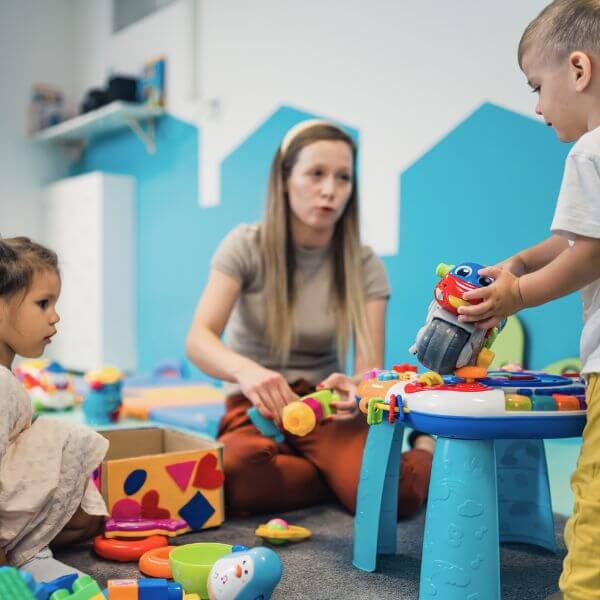Effective Alternatives for Suspension and Expulsion in Schools
September 30, 2024
September 30, 2024

As a special education teacher, have you ever had a moment when you wondered what you could have done differently? Maybe a student had a rough day and you left feeling drained or defeated because you had to send them home. Or maybe a student is struggling with challenging behaviors, but you’re not sure how you can best support them while also teaching the other 20 students in your classroom.
If this sounds familiar, you are not alone. Research tells us that educators across the country desire more training and resources centered around behavior systems, including creating and implementing effective Functional Behavior Assessments (FBA) and Behavior Intervention Plans (BIP). Another study shows that although students with disabilities make up an average of only 13% of the school population, they receive approximately 25% of out-of-school suspensions and 23% of expulsions. Hopebridge is working to change this and drive equity through our school-based services.
Recognizing that special education providers need more comprehensive resources, Hopebridge works with individual schools and school districts to provide professional development and tiered layers of support. These consultations and training opportunities cover everything from needs assessments and classroom setup to behavior management and specially designed instruction.
But what can teachers and administrators like you do right now to make a real impact? We turned to Hopebridge Director of School Based Services Ashley Walke to share low effort but highly effective classroom accommodations to address challenging behavior. Having worked with challenging behaviors in the special education field for more than 15 years to help students access their appropriate education, Ashley shared her top five recommendations for decreasing challenging behaviors in the classroom to reduce the need for exclusionary discipline.
Based on research and experience, we know there are numerous reasons why challenging behavior occurs, and school settings can heighten many of them.

Educators can get help from Hopebridge on ways to support students.
“Going to school means waking early, being surrounded by a lot of people, often-cold temperatures, with specific times to eat—much of which cannot be controlled. All of these physiological issues can start a child’s day already in a heightened state,” said Ashley. “Then compound that with any challenges the student may face from their disability, a lack of access to immediate help, and it really sets the stage for challenging behaviors right from the start.”
Ashley understands the challenges that students and teachers alike face in these moments. Those problem behaviors can escalate quickly when you add challenging work and a high student to teacher ratio. As the problem behavior escalates the teacher often needs to prioritize the learning and safety of the other students in the class which usually means the student with the challenging behavior gets sent to the office, or sent home. This not only leads the child to miss out on academics, which furthers their educational gap but it also infringes on their right to access a free and appropriate public education which is a legal requirement outlined in the Individuals with Disabilities Education Act (IDEA).
“There are antecedent, environmental and universal design strategies that we can put in place to mitigate these issues and keep children in the classroom.” said Ashley. “The goal is to stop behaviors before they occur by understanding what the student needs. It takes a little extra work up front but will cut down on the challenges overall.”
Following the Multi-Tiered Systems of Support – Behavior (MTSS-B) framework, Ashley provided recommendations for tier 1 and tier 2 strategies to give educators a taste of what they can learn more about within Hopebridge’s professional development seminars:
This sounds simple – and it can be! – but we need to ensure students feel comfortable at school. Think of Maslow’s hierarchy of needs. Like all of us, the biological needs of children must be met before they can appropriately perform in school. For example, if you have a cold classroom, keep sweatshirts or blankets for students to access. Some children may come to your classroom hungry, and though they may already receive meals at school, having additional snacks and drinks available for them can work wonders when it comes to decreasing challenging behaviors. Some students may be exceptionally tired and can barely keep their eyes open. Allow those students to rest their eyes before starting a challenging task.
It’s easy to take a curriculum off the shelf, use it, and expect all students to learn it, but it’s unrealistic to think there’s a one size fits all curriculum, and this can be another stage-setter for challenging behaviors. People learn in different ways, which is especially true in special education classrooms. How can you fine tune your lesson so everyone can access it? Some may need to see it, others hear it, and still others may need to do it to grasp the lesson.
In classrooms, students may struggle to gain the teacher’s attention, even if they follow the rules and raise their hand. If the teacher is busy, students may get frustrated while waiting. To address this, the teacher can set up a system from the start to make sure students can get their attention without causing disruptions. For example, a student might raise their hand and the teacher may point to the student to let them know they are seen, and the teacher will get to them when they have a moment. This way, students know their signal has been received and can wait patiently while the teacher continues what they were doing.

Behavior in the classroom can be hard to manage.
Instead of only pointing out mistakes, teachers and paraprofessionals should also recognize and praise students when they do something well, especially if it is something they typically struggle to accomplish. Simple phrases like, “I love how you raised your hand and asked that question,” can boost their confidence. Besides verbal praise, you can use other reinforcers, too. For instance, if a student who usually has trouble with writing activities picks up a pencil and starts working right away, you might reduce their workload a bit and give them a short break as a reward.
Regarding classroom expectations, Ashley uses the expression, “What hill are you willing to die on?” to suggest that teachers should think carefully about which rules are really important and justifiable. This is important because some arbitrary rules can escalate problem behavior resulting in disciplinary actions like suspension or expulsion, which could later be reviewed in mediation. For example, imagine if you have a rule that students should not put their heads down in class. If a student breaks this rule, it could lead to a power struggle and escalate into more serious behaviors, such as property destruction, then result in an extended suspension. If a parent brought the issue to mediation, would you feel comfortable explaining to the judge that it all started because the student wanted to put their head on their desk and you wouldn’t let them? Rules are important, however, especially regarding safety others are essential and should be upheld.
Many of these practices are already underway in Hopebridge’s home state of Indiana. Hopebridge is helping to implement an MTSS program and universal training.
For Ashley, the progress of the students in the intensive classroom Hopebridge is supporting is a testament to all the wonderful things the public education system can offer all students when providers and educators join forces and work together on behalf of those students facing significant challenges.
Ashley detailed a success story to highlight the wonderful work of the intensive classroom.
“One of the students in the supported class had historically engaged in significant challenging behaviors that resulted in numerous suspensions and ultimately being placed on homebound services. He started the year in the supported classroom, and he has completed more work in the first four weeks of school than he had across the whole previous academic school year,” said Ashley. “Not only is the classroom decreasing challenging behaviors, but it is also helping these students overcome academic deficits incurred due to the barriers their challenging behavior caused in accessing their education.”

Children with autism and differing abilities have unique needs in the classroom setting.
Providing development opportunities around reducing suspension, expulsion and other exclusionary practices is just one of the areas in which Hopebridge supports schools. We can work with your school or district to evaluate your data, determine the trends, and use it to tailor a development plan or program that directly addresses your needs.
As leaders in autism care for nearly two decades, including a team with extensive special education experience, we understand the unique needs of children with developmental delays and differing abilities, as well as those of educators like you. We have a working knowledge of federal and state legislation, such as the Individuals with Disabilities Education Act (IDEA), Section 504 of the Rehabilitation Act, Every Student Succeeds Act (ESSA), and Indiana’s Article 7.
“We know the teachers we work with were hired to be educators and not behavior specialists,” said Ashley. “That is where Hopebridge comes in; we can help the school or district create and implement these plans so teachers can focus on what they do best: educating the next generation.”
To learn more about how Hopebridge works with schools, please visit our school-based services page and fill out the form to arrange a consultation with our team.
*Informed consent was obtained from the participants in this article. This information should not be captured and reused without express permission from Hopebridge, LLC. Testimonials are solicited as part of an open casting call process for testimonials from former client caregivers. Hopebridge does not permit clinical employees to solicit or use testimonials about therapeutic services received from current clients (Ethics Code for Behavior Analysts 5.07-5.08; BACB, 2020). Hopebridge does not provide any incentives, compensation, or renumeration for testimonials provided by a former client or client caregiver.